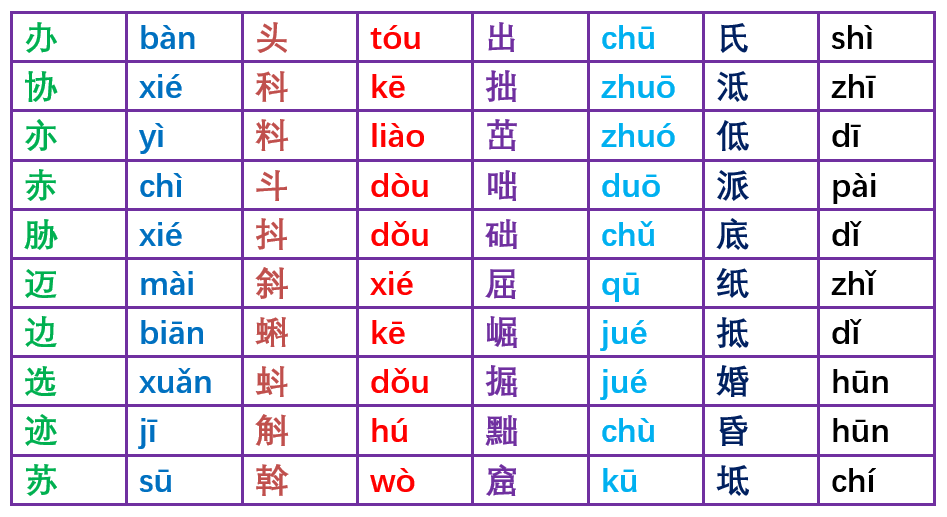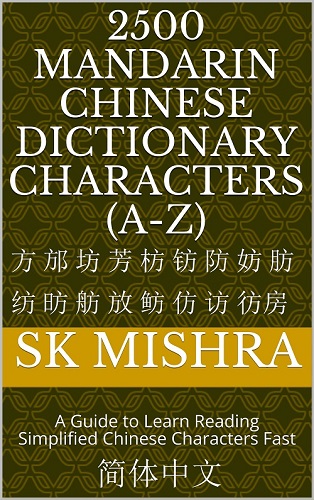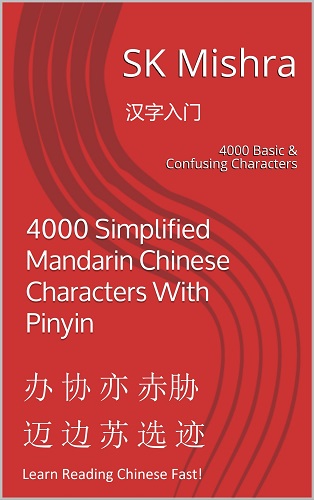Did you ever want to learn Mandarin Chinese? Or did you already start learning it, but feel like hitting a rocky mountain? Are you wondering how to remember the confusing characters? If so, then this blog-post (for learning Chinese characters) is for you!

Well, I moved to the mainland China in November-2017 and my base has been Suzhou (I often call Suzhou, in Jiangsu province, my Chinese hometown). Learning Mandarin Chinese was one of my goals when I decided to work in China. As such, I’ve been consistently studying Chinese. Although I practice learning Chinese virtually every day a couple of hours, at times I’ve spent 6-7 hours/day to dig the language deeper. The whole experience has largely been a positive one. In fact, recently I published a couple of books to learn Chinese. So, in this post, I’ll share some general tips for you, as a foreigner, to learn Mandarin Chinese reading fast.
Learn Chinese Language and Culture
Here are some of the related books/resources to learn Chinese language fast:
- Level 1: Chinese Reading Books (Chinese Elementary/Primary School Education Series)
- Level 1: Chinese Reading Books (Chinese Short Story Series, 500+ characters)
- Level 1: Chinese Reading Books (Journey to the West Series, 600 characters)
- Level 2: Chinese Reading Books (Biographies of China’s Famous Personalities, 600 characters)
- Level 2: Chinese Reading Books (Chinese Reading Comprehension, 600+ characters)
- Level 2: Chinese Reading Books (Chinese History Series, 900 characters)
- Level 3: Chinese Reading Books (Chinese Culture Series, 1000 characters)
- Level 4 & 5: Chinese Reading Books (Chinese Geography and Economy Series, over 1000 characters)
- Level 6: Chinese Reading Books (Chinese Classical Literature Masterpieces, about 1300 characters)

When it comes to learning a new language, Mandarin Chinese is just unique. I speak over 10 different languages (including Mandarin, English, Korean, Hindi), but my whole experience with the Chinese language system has been very different.
So, what’s the reason? What makes learning Chinese so time consuming (and complicated)? Well, the most fundamental aspect of learning Mandarin is remembering the Characters (reading and comprehension). However, unlike English, there is the no fixed alphabet in Chinese. You’ll literally need to remember the mysterious characters. How many of them are there? I’ll give you the numbers!
To be fluent in reading and intuitively understanding a randomly thrown Chinese manuscript, you’ll need to learn more than 4000 Chinese characters. You heard me right, you’ll need to remember thousands of Chinese characters in order to get a solid hand over the ancient language. Although the number may be astonishing for many of you, that’s a common consensus among the natives.
Fret not, I’m here to share with you some quick tips to help you learn the Mandarin Chinese reading fast (and of course, efficiently as well).
How to learn fast reading Mandarin Chinese characters?
Each of the Mandarin Chinese characters represents a unique pictograph and often carries numerous hidden socio-cultural meanings. Not to mention, remembering a Mandarin Chinese character is like remembering a unique painting (and associated meanings). That is to say, learning 4000 characters practically means remembering 4000 unique paintings. Obviously, it’s not going to happen overnight. It would take time. How much time? Well, that’s depend on how sincere (and smart) efforts you are willing to put into action. Nevertheless, a year of hard work would be the least you should expect to dedicate to remembering those mind-blowing 4000 Chinese characters.
That said, you can make your efforts smarter. In fact, there is a lot of scope to learn Chinese reading fast!
There are two broad concepts that I’ve heavily used to read/memorize the Chinese characters. Without further due, I’ll give you a quick overview of these two methods.
Method 1- Learn reading similar Mandarin Chinese characters together
There are so many Chinese characters that look similar and have similar pinyin (with tones being either same or different). Therefore, preparing a list of such similar characters would be very helpful to speed up the whole process of learning the characters fast. Here are a few examples, look at each of the character columns and their corresponding pinyin in the next column:
| 主 | zhǔ | 只 | zhī | 中 | zhōng | 俞 | yú |
| 拄 | zhǔ | 织 | zhī | 忠 | zhōng | 揄 | yú |
| 住 | zhù | 职 | zhí | 盅 | zhōng | 嵛 | yú |
| 注 | zhù | 枳 | zhǐ | 钟 | zhōng | 逾 | yú |
| 驻 | zhù | 轵 | zhǐ | 衷 | zhōng | 渝 | yú |
| 柱 | zhù | 咫 | zhǐ | 螽 | zhōng | 愉 | yú |
| 炷 | zhù | 疻 | zhǐ | 肿 | zhǒng | 瑜 | yú |
| 砫 | zhù | 识 | zhì | 种 | zhǒng | 榆 | yú |
| 疰 | zhù | 帜 | zhì | 仲 | zhòng | 窬 | yú |
As evident, the character 主 (zhǔ) is part of each of the characters in the first column (the character radicals vary though). No wonder, the pronunciations are also related. The similar concept can be observed in the other columns as well.
When I started learning the Mandarin Chinese language, it took me some time to realize this completely simple concept. Later, I spend years collecting and organizing the characters based on the pictographic and phonetic similarity. If you don’t want to spend years collecting those similar characters like me, you can just follow the characters in the following book editions: the characters (with pinyin and corresponding meaning) are available on Amazon in a single book volume (both Kindle and Paperback).

- Paperback: Amazon
- Paperback: Barnes & Noble
Method 2 – Learn reading confusing Mandarin Chinese characters together
In the Method 1, we saw certain characters that looked similar and had similar sounds. However, there are numerous Mandarin characters that look similar but are essentially not the same – their pronunciations may be very different. That is to say, their pinyin, pronunciations and meanings may be totally unrelated. Again, for example, check out each of the columns in the following table:
| 须 | xū | 音 | yīn | 厅 | tīng | 拓 | tà |
| 彰 | zhāng | 普 | pǔ | 衍 | yǎn | 碧 | bì |
| 彩 | cǎi | 晋 | jìn | 手 | shǒu | 祐 | yòu |
| 衫 | shān | 善 | shàn | 灯 | dēng | 石 | shí |
| 杉 | shān | 尊 | zūn | 订 | dìng | 左 | zuǒ |
| 影 | yǐng | 遭 | zāo | 打 | dǎ | 右 | yòu |
| 彭 | péng | 膳 | shàn | 钉 | dīng | 岩 | yán |
| 嘭 | pēng | 嗮 | sài | 行 | xíng | 若 | ruò |
| 彤 | tóng | 晒 | shài | 咑 | dā | 磊 | lěi |
| 形 | xíng | 酋 | qiú | 芋 | yù | 惹 | rě |
| 澎 | pēng | 菩 | pú | 丁 | dīng | 佐 | zuǒ |
| 彬 | bīn | 谱 | pǔ | 叮 | dīng | 佑 | yòu |
| 膨 | péng | 媳 | xí | 盯 | dīng | 宕 | dàng |
| 彪 | biāo | 曝 | pù | 汀 | tīng | 喏 | nuò |
You may observe that in the first column, the hair radical 彡 (shān) is a common theme and so is the 丁 (dīng) character in the third column. Basically, you can put the similar looking characters together and learn them. Why? Because this will unconsciously reinforce your brain to correctly distinguish the similar looking characters. The more characters you study, the more common themes your brain would be able to recognize.
Again, you would find the well-organized list of the similar looking confusing Mandarin Chinese characters (with pinyin) in the following book editions-

- Paperbacks: 4000 Simplified Mandarin Chinese Characters With Pinyin
- Paperback: Amazon
- Paperback: Barnes & Noble
What’s more, the books, organized into simple tabular chapters, also provide other useful information about learning Mandarin Chinese, such as:
- 100 most frequently use characters;
- Introduction to the character radicals (such as 彡, shān);
- List of Chinese provinces;
- Short names of Chinese provinces;
- List of Chinese names, surnames.
Basically, if you are intending to read and interpret the characters like the native Chinese do, you’ll have to learn/remember reading over 4000 Chinese characters. There is just no shortcut or substitute for remembering them!
Mandarin Chinese Reading Practice Books
Once you start learning Chinese characters, it is recommended to start reading the related textbooks as well in order to closely understand usage of those characters. Reading beginner’s books would not only reinforce you to interpret the meaning of the characters, but also help you to remember and distinguish confusing characters in the long-term. However, finding a suitable book, especially for the beginners (Level 1) could be tricky for the nonnative learners.
So, here are some of the recommended books to practice Mandarin Chinese reading. Each of the following books contains only about 600 characters and the corresponding pinyin is provided. That is to say, the English text is intentionally excluded and you’ll need to read the sentences and connect the meanings. Of course, these books are for the beginners (Level 1/2), so nothing to worry! Here is the list of books for Chinese reading practice:
1500 Chines Words
- Paperback: Amazon
- Paperback: Barnes & Noble
Book 1- Journey to the West Series
- Paperback: Monkey King 1, 600 characters.
Book 2- Journey to the West Series
- Paperback: Monkey King 2,
Although the Mandarin Chinese is arguably a very different language, there is a lot of scope to learn the language fast. The more you practice the characters, the better you’ll become. Once you have learned the 4000 Chinese characters, reading a random piece of Chinese text would be a piece of cake.
That’s all in this post about How to learn fast reading Mandarin Chinese characters. If you have any question about learning Mandarin Chinese, traveling, living or working in China, do let me know in the comments! Feel free to post in our forum so that others could also contribute and learn. For regular updates like us on Facebook, or follow on Twitter!
If you find the write-ups useful, don’t forget to buy me a beer!
Wish you a great time learning Mandarin Chinese!
Cheers!
Last updated: Monday, May 20, 2024
Great post. I’m going to check out the books. I’ve been studying Mandarin for a year. I only know a handful of characters(400). The more I learn, the more I’m amazed how much I remember. It didn’t take long for my brain to start seeing the connections and patterns. I use a few different resources but I always welcome any new resources.
It helps that I have a lot of Chinese friends visiting America for one reason or another. I constantly listen to them talk to pick out the characters I do know. I can find my way around characters when reading them, but realistically my listening/speaking comprehension; I feel like I’ll be studying for years. I fell in love with the language and also like researching all of the new characters I learn.
You are welcome.
400 is a good start, however, certainly not enough. Try to do reading practice (starting with Level 1) as much as you can, that’d reinforce learning. The more books you are able to read, the more characters you’d be able to understand.
Best wishes. 🙂
You are awesome !
Thanks for stopping by. 🙂